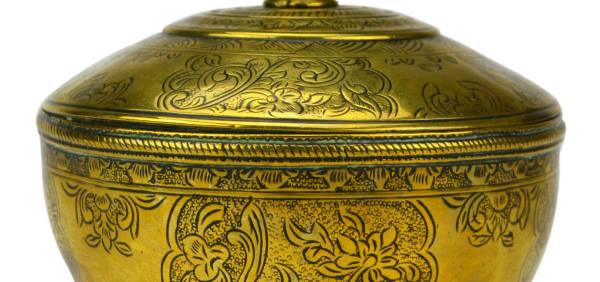Polish brasses by hand.
Use modern paste-type polish with microabrasives.
If brass hardware is removed prior to polishing, remove one piece at a time, polish, and replace it before moving on to next piece.
Cautions
Mechanical buffing wheels can damage brass surfaces.
When polishing while brass remains on furniture, do not polish brass edges without taking care to protect surrounding wood finish.
The composition of brass, on average, is 65 percent copper, 30 percent zinc, and 5 percent other minerals. Like any other material, when brass is exposed to air it develops a surface patina or tarnish. When first made, furniture brasses are polished bright and then shellacked. This is how bronze-fitted furniture is intended to look. Originally this shellac-based finish, used for all brasses, kept the brass appearing polished.
Shellac is a natural finish that may be refined in numerous ways in order to obtain different grades of finish. For brass finishing, shellac was tinted with natural dyes and colorants, ranging from dark brown to clear amber, to obtain a transparent, gold-color finish. Another process, called fire gilding, was also used: After being covered with a mercury and gold-powder mixture, the brass was fired to obtain a golden-colored coating.
Time and use wears off the shellac finish, permitting the now-exposed brass in some areas to tarnish to a darker color. To keep a bright, uniform-looking brass, polish began to be used.
Once the decision to polish brasses has been reached, several issues should be considered. First of all, I recommend polishing brasses by hand exclusively. I caution against using a buffing wheel, which can cause severe damage to the brass, burning off its surface details with polishing compounds.
Though you won’t be the first to polish the brass on your furniture, you should still exercise care during the process. Brasses with original surfaces are rarely found. Usually, small areas of gold- or amber-colored shellac will be present. If this is the case, and the piece is a valuable antique, consult a conservator or restorer before undertaking any polishing yourself. Polishing brass is a conservation issue and, therefore, I feel it is best to consult a conservator, who can help establish guidelines for polishing each piece of furniture.
Protecting the Finish
If you intend to wax the piece of furniture as part of the finishing process, applying a light coat of wax around the perimeters of the brasses will help protect the wood’s finish during brass polishing.
Most often, brasses are polished in place on the furniture rather than first being removed. If you choose to work with the brasses attached to the piece, care should be taken to protect the wood surface, especially the original one. The easiest method is to insert an index card between brasses and wood.
Then is it best to remove brasses prior to polishing?
Only if you are willing to take some precautions first. For example, through use, brasses become worn and develop a “fit.” This should be maintained, and the best way to make certain that each piece is returned to its original position is to remove a single brass fitting, polish it, then put it back in place before moving on to another piece. Alternatively, you can place each piece on a layout board, guaranteeing return to its original location.
A built-up residue from previous polishing is often seen around and under brasses. Use a soft brush to remove this build-up, then carefully vacuum the bits off the piece. Follow this with a cloth lightly dampened with water.
If I leave brasses on the furniture, should I polish their edges as well?
Trying to polish the edges of brasses while still installed on furniture is impossible to do without rubbing and damaging the wood finish. You may have seen furniture that had lighter areas around the brasses. This came about from polishing the edges of brasses while they were still situated on the furniture, with no protection or regard for the finish.
How To Polish Brasses
I recommend using modern paste-type brass or metal polishes that use microabrasives. Simichrome, Four Star Metal Polish, and Flitz are all brands I trust. Older liquid polishes use abrasives such as pumice, rottenstone, or tripoli, which are suspended in an ammonia-based solution. These solutions are much more aggressive than paste polishes that contain microabrasives and thus can potentially do more damage to the furniture finishes than paste polishes.
I like to apply the polish with cheesecloth, which lifts up tarnish and dirt rather than holding it on the brass surface the way a smooth cotton cloth can. Use small pieces of cloth and change them frequently. Polish the brass until the degree of brightness you prefer has been reached. Buff off the brass with a soft paper towel, which will tear off rather than grab at the points of the brass.
Once completed, any polish residue should be removed. Microcrystalline waxes, such as Renaissance Wax, remove this residue well and also provide a layer of protection for the brasses. The frequency with which you polish brasses is a personal choice.
Should I have the brasses shellacked?
Shellacking brasses is the only way to prevent constant tarnishing and polishing. If you like bright brasses and would rather not be bothered with polishing, shellacking should be considered.
But polishing provides an excellent opportunity to become more familiar with your antique furniture. Take some time to study brass hardware. Just like the piece of furniture that bears them, brasses are artifacts to enjoy and study.



